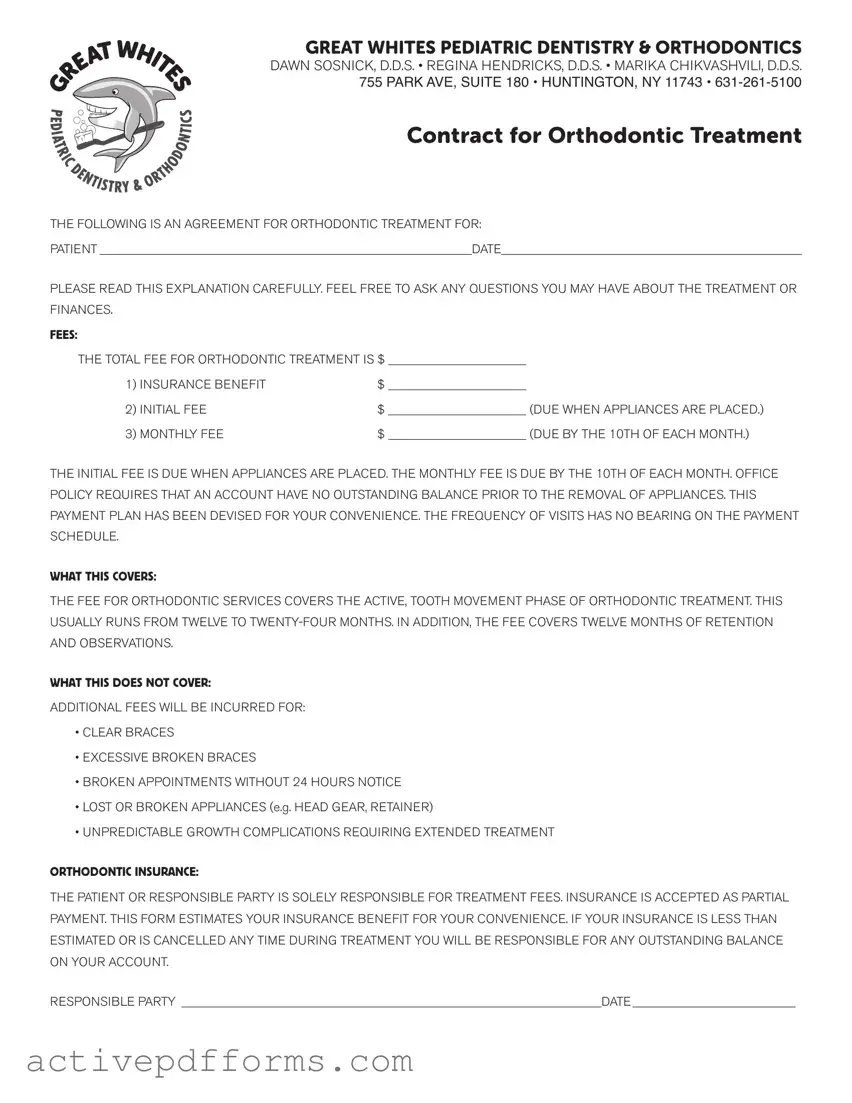GREAT WHITES PEDIATRIC DENTISTRY & ORTHODONTICS
DAWN SOSNICK, D.D.S. • REGINA HENDRICKS, D.D.S. • MARIKA CHIKVASHVILI, D.D.S. 755 PARK AVE, SUITE 180 • HUNTINGTON, NY 11743 • 631-261-5100
CONTRACT FOR ORTHODONTIC TREATMENT
THE FOLLOWING IS AN AGREEMENT FOR ORTHODONTIC TREATMENT FOR:
PATIENT ____________________________________________________________DATE________________________________________________
PLEASE READ THIS EXPLANATION CAREFULLY. FEEL FREE TO ASK ANY QUESTIONS YOU MAY HAVE ABOUT THE TREATMENT OR FINANCES.
FEES:
THE TOTAL FEE FOR ORTHODONTIC TREATMENT IS $ ______________________
1) INSURANCE BENEFIT |
$ ______________________ |
2) INITIAL FEE |
$ ______________________ (DUE WHEN APPLIANCES ARE PLACED.) |
3) MONTHLY FEE |
$ ______________________ (DUE BY THE 10TH OF EACH MONTH.) |
THE INITIAL FEE IS DUE WHEN APPLIANCES ARE PLACED. THE MONTHLY FEE IS DUE BY THE 10TH OF EACH MONTH. OFFICE POLICY REQUIRES THAT AN ACCOUNT HAVE NO OUTSTANDING BALANCE PRIOR TO THE REMOVAL OF APPLIANCES. THIS PAYMENT PLAN HAS BEEN DEVISED FOR YOUR CONVENIENCE. THE FREQUENCY OF VISITS HAS NO BEARING ON THE PAYMENT SCHEDULE.
WHAT THIS COVERS:
THE FEE FOR ORTHODONTIC SERVICES COVERS THE ACTIVE, TOOTH MOVEMENT PHASE OF ORTHODONTIC TREATMENT. THIS USUALLY RUNS FROM TWELVE TO TWENTY-FOUR MONTHS. IN ADDITION, THE FEE COVERS TWELVE MONTHS OF RETENTION AND OBSERVATIONS.
WHAT THIS DOES NOT COVER:
ADDITIONAL FEES WILL BE INCURRED FOR:
•CLEAR BRACES
•EXCESSIVE BROKEN BRACES
•BROKEN APPOINTMENTS WITHOUT 24 HOURS NOTICE
•LOST OR BROKEN APPLIANCES (E.G. HEAD GEAR, RETAINER)
•UNPREDICTABLE GROWTH COMPLICATIONS REQUIRING EXTENDED TREATMENT
ORTHODONTIC INSURANCE:
THE PATIENT OR RESPONSIBLE PARTY IS SOLELY RESPONSIBLE FOR TREATMENT FEES. INSURANCE IS ACCEPTED AS PARTIAL PAYMENT. THIS FORM ESTIMATES YOUR INSURANCE BENEFIT FOR YOUR CONVENIENCE. IF YOUR INSURANCE IS LESS THAN ESTIMATED OR IS CANCELLED ANY TIME DURING TREATMENT YOU WILL BE RESPONSIBLE FOR ANY OUTSTANDING BALANCE ON YOUR ACCOUNT.
RESPONSIBLE PARTY ___________________________________________________________________DATE __________________________

